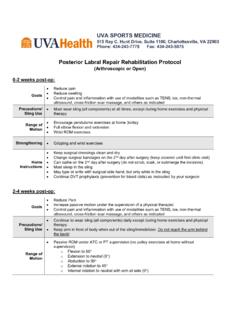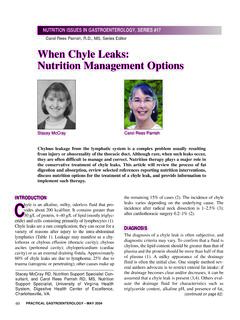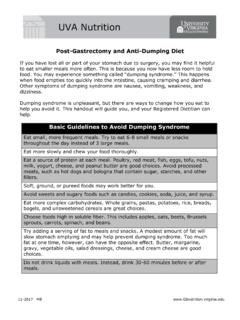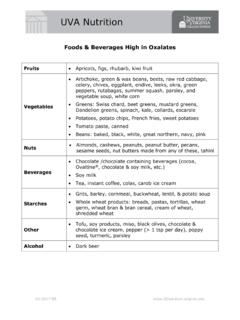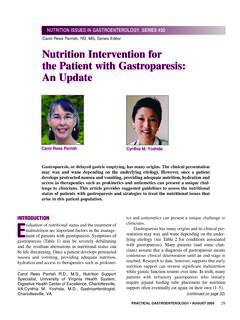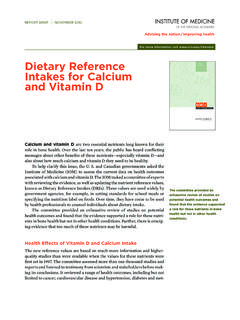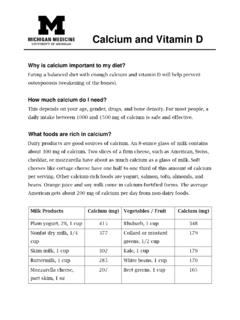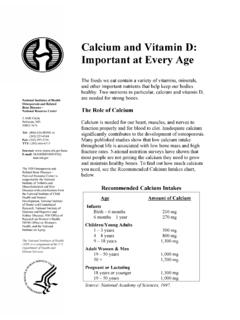Transcription of Calcium and Vitamin D - UVA
1 Calcium and Vitamin D. The Importance of Calcium Calcium has many jobs in your body: it helps muscles contract (including your heart!), helps blood clot, sends nerve messages, and keeps bones strong. In fact, 99% of the Calcium in your body is in your bones and teeth. You must eat Calcium every day; otherwise your body will take it from your bones. Over time, this will cause you to have fragile bones that break easily. Osteoporosis is a disease in which bones lose Calcium and become weak. People with osteoporosis have a higher risk of fractures, developing kyphosis ( , a hump back ), and losing height.
2 Some people are at higher risk for osteoporosis. Factors you cannot Factors you can control: control: Not enough Calcium and Vitamin D in your Being female diet Post-menopausal Not enough fruits and vegetables in your Over age 50 diet Family history Not enough exercise Small bone frame Smoking and drinking alcohol and/or lean build Losing weight if you are overweight Recommended Calcium Intake How much Calcium you need depends mainly on your age and gender. If you are keeping track of your Calcium intake, don't forget to count food sources and Calcium in supplements.
3 Women under 50: 1000 mg daily Men under 70: 1000 mg daily Women over 50: 1200 mg daily Men over 70: 1200 mg daily Calcium Content of Foods Dairy products like milk, yogurt, and cheese are rich in Calcium and also tend to be the best absorbed sources. There are also some good non-dairy sources. 11-2017 MB Food Serving Calcium Size Content* (mg). Plain yogurt (NOT Greek) 1 cup 400. Calcium fortified orange juice 1 cup 350. Milk 1 cup 300. String cheese 1 stick 200. Feta cheese, crumbled cup 185. Kidney beans cup 180.
4 Collard greens (cooked) cup 175. Low fat cottage cheese 1 cup 150. Spinach (cooked) cup 120. Frozen yogurt cup 105. Turnip greens (cooked) cup 100. Edamame 1 cup 70. Broccoli spears (cooked) cup 45. Soy milk** 1 cup Up to 350; varies widely by brand Fortified cereals 1 serving Up to 1000; varies widely by brand * Calcium content of foods may vary; read labels to determine the actual Calcium content of a certain food. ** The nutrient content of soy milk varies greatly depending on the manufacturing process and whether the product is fortified.
5 The Importance of Vitamin D. You cannot absorb the Calcium you eat without enough Vitamin D. Vitamin D. is called the sunshine Vitamin because under some conditions, your body can make enough of it if you expose your skin to the sun. However, this depends on the time of the year, where you live, your skin color, and if you are wearing sunscreen. Many people don't spend enough time with their skin exposed to the sun to get enough Vitamin D. Vitamin D is also found in a few foods: mainly dairy products that have been fortified, egg yolks, and fatty fish like salmon and herring.
6 Many foods are now fortified with Calcium and Vitamin D, too. Breakfast cereals, orange juice, breakfast bars, soy milk, tofu, and even some margarine now contain added Calcium or Calcium plus Vitamin D. If you don't eat enough Vitamin D foods and if you do not get enough sunlight exposure, you may need a Vitamin D supplement. Ask your doctor and/or Registered Dietitian. 11-2017 MB Recommended Vitamin D Intake Age group Vitamin D (IU). Infants (up to 12 months) 400. Children & adults 600. ages 1-70.
7 Adults over age 70 800. Select Food Sources of Vitamin D. Food Serving size Vitamin D. (IU). Salmon, pink, canned (without skin & bones) 3 oz 480. Fortified milk (skim, low fat, whole, or soy) 1 cup 100-120. Fortified breakfast cereals (check labels) 1 oz 40-50. Egg with yolk 1 large 40. Cheddar cheese 1 oz 7. Other Considerations Some people may benefit from higher doses of Calcium and Vitamin D. Ask your physician and/or Registered Dietitian about how much you should be getting: If you are a post-menopausal woman If you have inflammatory bowel disease (IBD), celiac disease, gastric bypass, or nutrient malabsorption If you are taking corticosteroid or certain antibiotic medications ( steroids ).
8 You may also want to ask your doctor whether you need a bone density study if you have any of these conditions. Calcium and Vitamin D Supplements If you are unable to get enough Calcium through diet alone, Calcium supplements are available. The most common types of Calcium supplements are Calcium carbonate and Calcium citrate. Calcium carbonate is more commonly available and less expensive. Calcium is best absorbed in doses of 500 mg or less and when taken with meals. If you need to take more than 500 mg per day, consider taking several smaller doses throughout the day.
9 11-2017 MB Because they work together, many Calcium supplements come with some Vitamin D. Vitamin D also commonly comes in multivitamin supplements as well as alone in higher doses. Ask your doctor or Registered Dietitian before starting a Vitamin D supplement because it is possible to take too much . very high levels may be toxic. Commonly Available Combined Calcium and Vitamin D Supplements Type of Calcium Calcium (mg) Vitamin D (IU). Calcium Carbonate Tums 200 0. Extra Strength Tums 300 0. Tums Ultra 400 0.
10 Oscal Calcium + D3 500 200. Oscal Extra + D31 500 600. Oscal Ultra 2 600 500. Citracal Calcium Pearls 200 500. Caltrate 600 + D3 600 800. Caltrate 600 + D3 Plus Minerals1, 2 600 800. Viactiv 2 500 500. Calcium Citrate Citracal regular 250 200. Citracal Maximum 315 250. Citracal Petites with Vitamin D 200 250. Citracal Plus Magnesium2 250 125. 1. Available in chewable form. 2. Contains additional vitamins &/or minerals; also, Viactiv contains 20 calories per piece. Additional Resources For more information on Calcium and Vitamin D, see the National Osteoporosis Foundation and the National Institute of Health websites: and 11-2017 MB

